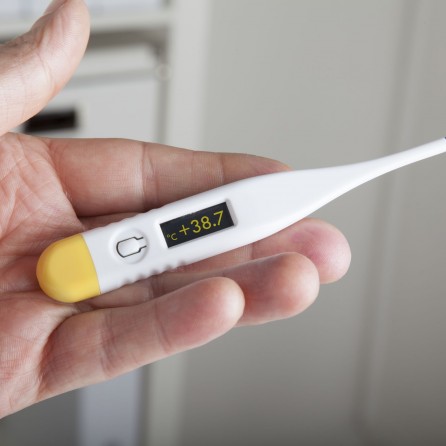
Fever can be particularly difficult for people with multiple sclerosis (PwMS) because of the heat stress caused by temperature increases. Although regular cold and flu symptoms can be bad enough, fever can also make existing or old MS symptoms worse, as well as causing periods of ‘cold chills’. PwMS can be sensitive to hot or cold temperatures, or both, so it is important to maintain a comfortable and consistent body temperature as much as possible.
Although it is normal for body temperature to vary during the day between 36°C and 37.5°C, it is not normal for your temperature to rise above 38°C (low grade fever) or even 39°C (high grade), and this is usually an indication of infection.
When a fever coincides with a cold or flu, this may simply be a sign of the body’s own defence mechanism for dealing with the infection. Our white blood cells tell the brain to increase body temperature to make the virus or bacteria uncomfortable and aid the immune system to fight the infection. This is highly effective, but the resulting heat stress can have unpredictable results for PwMS.
For PwMS, symptoms can get worse without an increase in lesions – this is all known as a ‘pseudo-exacerbation’ or pseudo-relapse, which can mean both a return of old symptoms or a worsening of existing ones.
Although these symptoms should return to a normal baseline level as the body cools (Uhthoff’s phenomenon), as can be seen during exercise, it can make the already very unpleasant flu even more debilitating for PwMS, as it will often worsen fatigue, cognitive problems, balance and visual disturbance.
Although ‘cold chills’ can be felt because of exposure to a cold environment, they are often felt with a fever and can cause shivering and shaking. This is because your muscles are relaxing and contracting rapidly while the vessels in your skin constrict. The chills can be constant and can last from several minutes to an hour. Your body may be using the chills to boost its core temperature, so although you may feel cold, your body temperature could be high (a rigor).
Treatment will depend on whether your chills are accompanied by a fever. Over-the-counter medications can fight the chills by reducing a fever. Make sure that you drink plenty of fluids and rest. Although taking a cool shower can reduce a fever, cold water can trigger an episode of chills, so ideally sponge your body with lukewarm water or wait until the fever has passed.
Some PwMS find that they are sensitive to hot temperatures and some find that cold temperatures make their symptoms worse. Others are sensitive to both hot and cold temperatures, and so it is important to maintain an optimum temperature. Sometimes a lesion in the area of the brain which controls temperature regulation can mean that the person doesn’t shiver to warm up, and so stays cold. Being cold can affect the speed at which the messages pass along the MS damaged nerves which can increase MS symptoms.
Ways of coping with MS and low body temperature include wearing clothing such as thermal underwear and socks, a hat, scarf and gloves when going out. Electric blankets can also make you more comfortable at home, but be careful it doesn’t get too hot — ideally get an electric blanket with a variable temperature control. Avoid alcohol as it increases blood flow to the skin which cools you even more. Also try to exercise as much as possible to avoid stiffness and improve your circulation. If you are affected by both cold and hot temperatures, try flexible solutions such as layering clothes and adding to them or removing layers as needed.
If you have a fever it is important to keep in mind that a change in core body temperature can worsen MS symptoms and that heat is the most common culprit for this. It is therefore important to keep your temperature down if you are ill with a fever. The best strategy is to ride out the fever by keeping it as close to 37°C as possible. Talk to your doctor or pharmacist about over-the-counter medications that can reduce your fever, and keep the right supplies in stock in case illness strikes.
If you experience worsening MS symptoms make sure that you listen to your body and try the different strategies below so that you find the one which works for you:
Your temperature spikes above 40°C
You’ve had a high grade fever for more than three days, without signs of it letting up
A fever being accompanied by:
Severe diarrhoea
Rash
Severe headache
Neck stiffness
Being bothered by bright light (photophobia)
Confusion
Problems staying awake
Or any other signs of serious illness